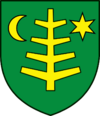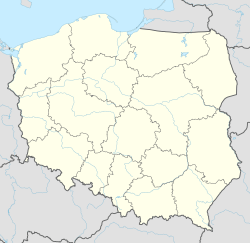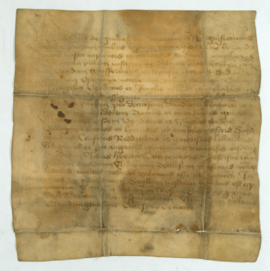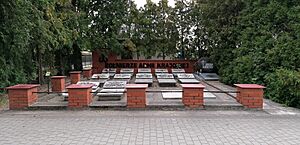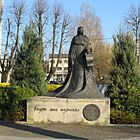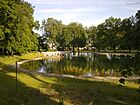Ostrów Mazowiecka facts for kids
Quick facts for kids
Ostrów Mazowiecka
|
|||
|---|---|---|---|
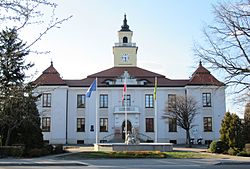
Town hall
|
|||
|
|||
| Country | |||
| Voivodeship | Masovian | ||
| County | Ostrów Mazowiecka | ||
| Gmina | Ostrów Mazowiecka (urban gmina) | ||
| Established | 14th century | ||
| Town rights | 1434 | ||
| Area | |||
| • Total | 22.09 km2 (8.53 sq mi) | ||
| Elevation | 110 m (360 ft) | ||
| Population
(2013)
|
|||
| • Total | 22,796 | ||
| • Density | 1,031.96/km2 (2,672.8/sq mi) | ||
| Time zone | UTC+1 (CET) | ||
| • Summer (DST) | UTC+2 (CEST) | ||
| Postal code |
07-300, 07-302
|
||
| Area code(s) | +48 029 | ||
| Car plates | WOR | ||
| Highways | |||
| National roads | |||
| Voivodeship roads | |||
| Website | http://www.ostrowmaz.pl | ||
Ostrów Mazowiecka is a town located in eastern Poland. In 2004, about 23,486 people lived there. It is the main town of Ostrów Mazowiecka County in the Masovian Voivodeship.
Contents
History of Ostrów Mazowiecka
Ostrów became a town in 1434. This special right was given by Duke Bolesław IV of Warsaw. The town's name comes from an old Polish word, ostrowa. In 1461, a school for the local church was started here.
In 1514, Duchess Anna Radziwiłł helped the town grow. She started four yearly fairs and a weekly market. There is a monument in town to remember her. In the 16th century, Polish King Sigismund II Augustus built a home in Ostrów. The town was a royal town in Poland. It was part of the Masovian Voivodeship.
Ostrów Mazowiecka in the 18th and 19th Centuries
People from Ostrów took part in the Kościuszko Uprising in 1794. This was a fight for Poland's freedom. But the next year, in 1795, Prussia took over the town. This happened during the Third Partition of Poland.
In 1807, Ostrów became part of the Duchy of Warsaw. This was a short-lived Polish state. Then, in 1815, it joined Congress Poland. This area was controlled by Russia. Many people from Ostrów fought in the January Uprising of 1863–1864 against Russia. An insurgent hospital was even set up in the town.
The people of Ostrów faced harsh treatment from Russia. Polish fighters were executed here, and memorials mark these spots. Despite this, Polish groups were formed in Ostrów. In the 1800s, many Jewish people moved to the town. This was due to Russian rules. By 1897, about 5,660 of the 10,471 people living in Ostrów were Jewish.
Ostrów Mazowiecka in the 20th Century
During World War I, Germany took control of Ostrów. After the war, in 1918, Poland became independent again. Ostrów was part of this new Poland. In 1919, a group of Polish soldiers trained in Ostrów. They were part of the Polish 15th Wolves Infantry Regiment. They helped fight in the Polish–Soviet War. A battle was fought near the town in 1920 during this war.
World War II in Ostrów Mazowiecka
World War II started in 1939. Germany took Ostrów Mazowiecka on September 8, 1939. Soon after, German groups arrived to harm the people. On September 19, Germans arrested nine Poles. Among them were leaders of local veteran groups.
On November 9, 1939, a German soldier set fire to buildings. The German authorities blamed the Jewish people for this. On November 11, a very sad event happened. Between 500 and 800 Jewish people were killed by German police. This is known as the Ostrów Mazowiecka massacre.
The Polish underground resistance started in Ostrów in late 1939. Many groups worked together to fight the occupation. They formed a district of the Home Army. This group did military actions, spying, and sabotage. They also ran secret Polish schools. They printed and shared hidden Polish newspapers.
On May 1, 1943, the Home Army blew up a German office. This was a response to Germans forcing local people to work. On May 25, 1943, the Polish resistance killed the head of the local German government. In return, the Germans killed about 140 Poles.
The German occupation ended in 1944. Ostrów was returned to Poland. However, a new government was put in place by the Soviet Union. This government stayed until the 1980s. Many members of the Home Army were arrested by the new government. They were sent to the Soviet Union. Many continued to fight against the new communist rule.
| Historical population | ||
|---|---|---|
| Year | Pop. | ±% |
| 1897 | 10,471 | — |
| 1921 | 13,425 | +28.2% |
| 1931 | 17,611 | +31.2% |
| 2010 | 22,536 | +28.0% |
Transportation in Ostrów Mazowiecka
Ostrów Mazowiecka is located where two main Polish highways meet. These are S8 and S61.
International Connections
Twin Towns and Sister Cities
Ostrów Mazowiecka has special connections with other cities around the world. These are called twin towns or sister cities:
Notable People from Ostrów Mazowiecka
Many interesting people have come from Ostrów Mazowiecka:
- Asher Zebi of Ostrowo (19th century), a religious leader (rabbi)
- Jadwiga Długoborska (1899–1944), a teacher and social worker
- Jan Dołęga-Zakrzewski (1866–1936), a politician and mayor of Ostrów Mazowiecka
- Beata Mazurek (born 1967), a politician
- Krystyna Sienkiewicz (1934–2017), an actress and singer
Gallery
See also
 In Spanish: Ostrów Mazowiecka para niños
In Spanish: Ostrów Mazowiecka para niños



